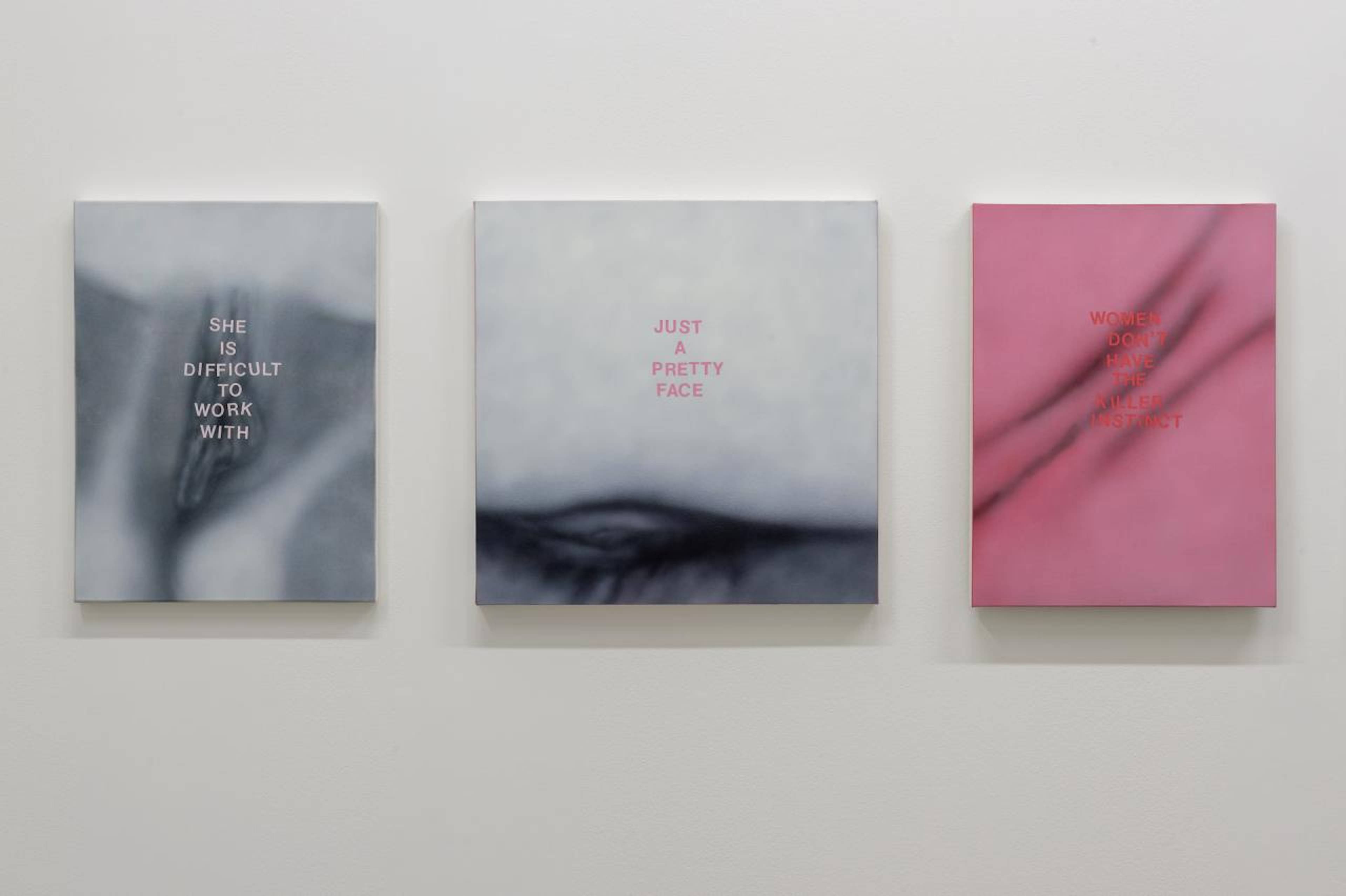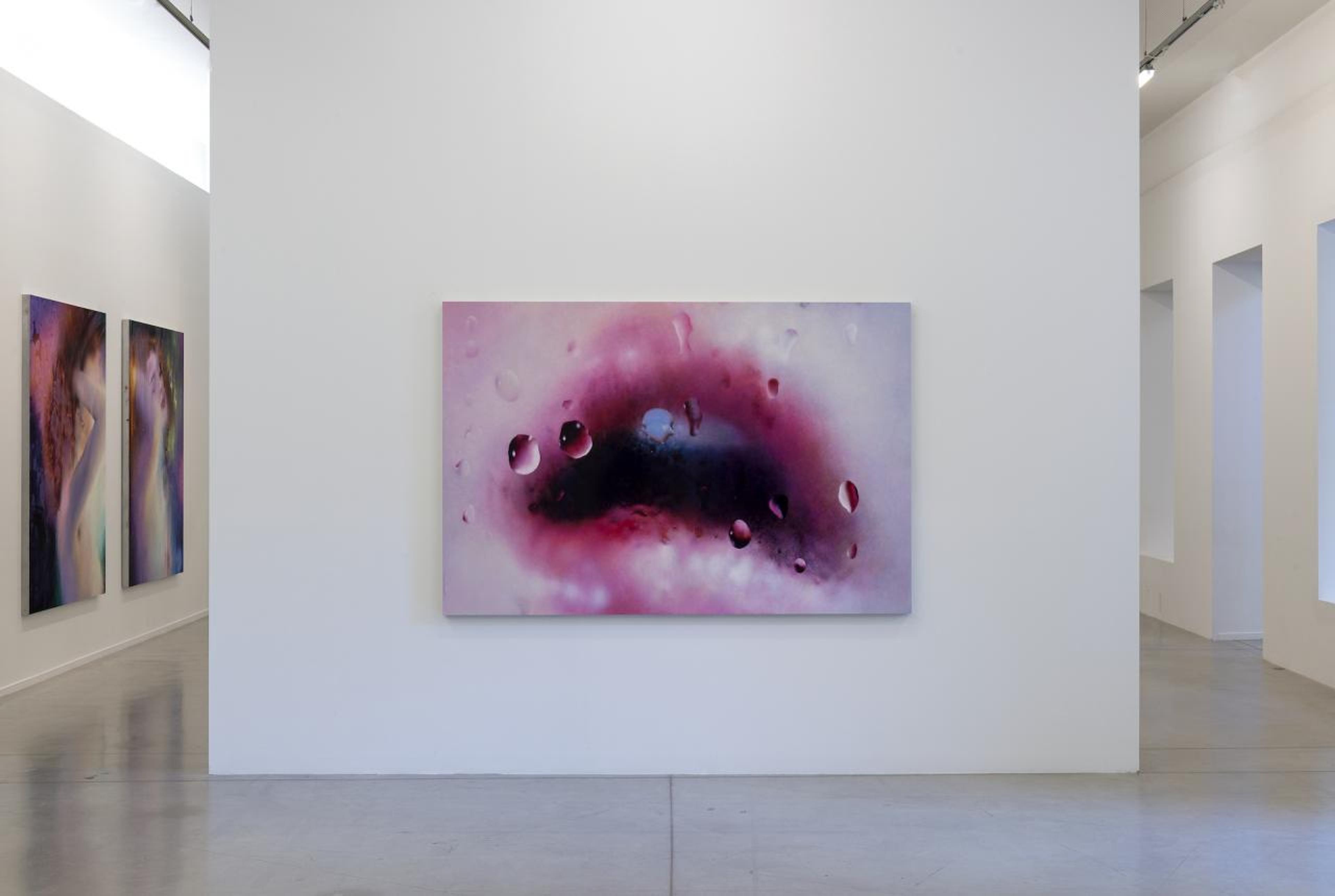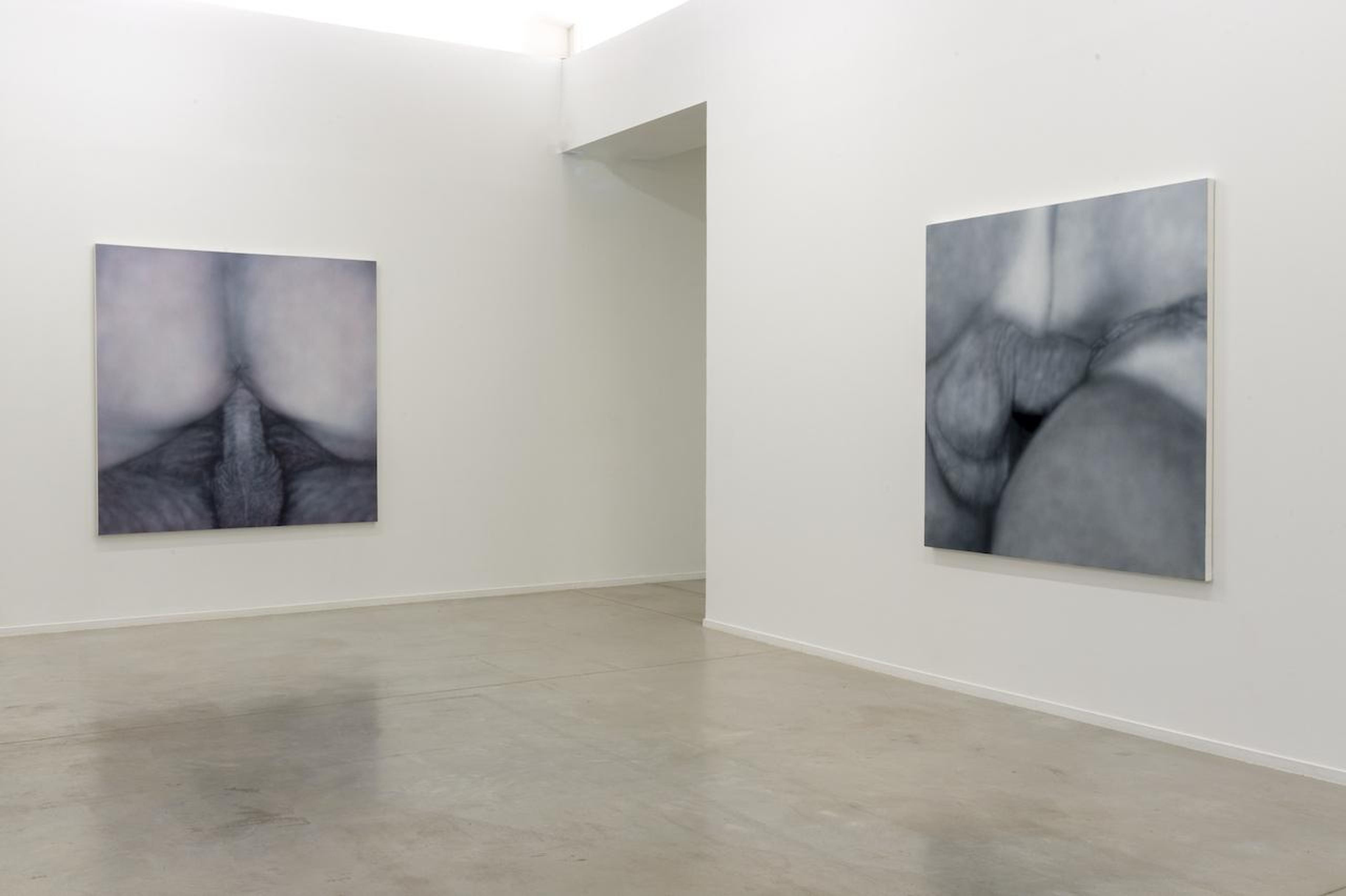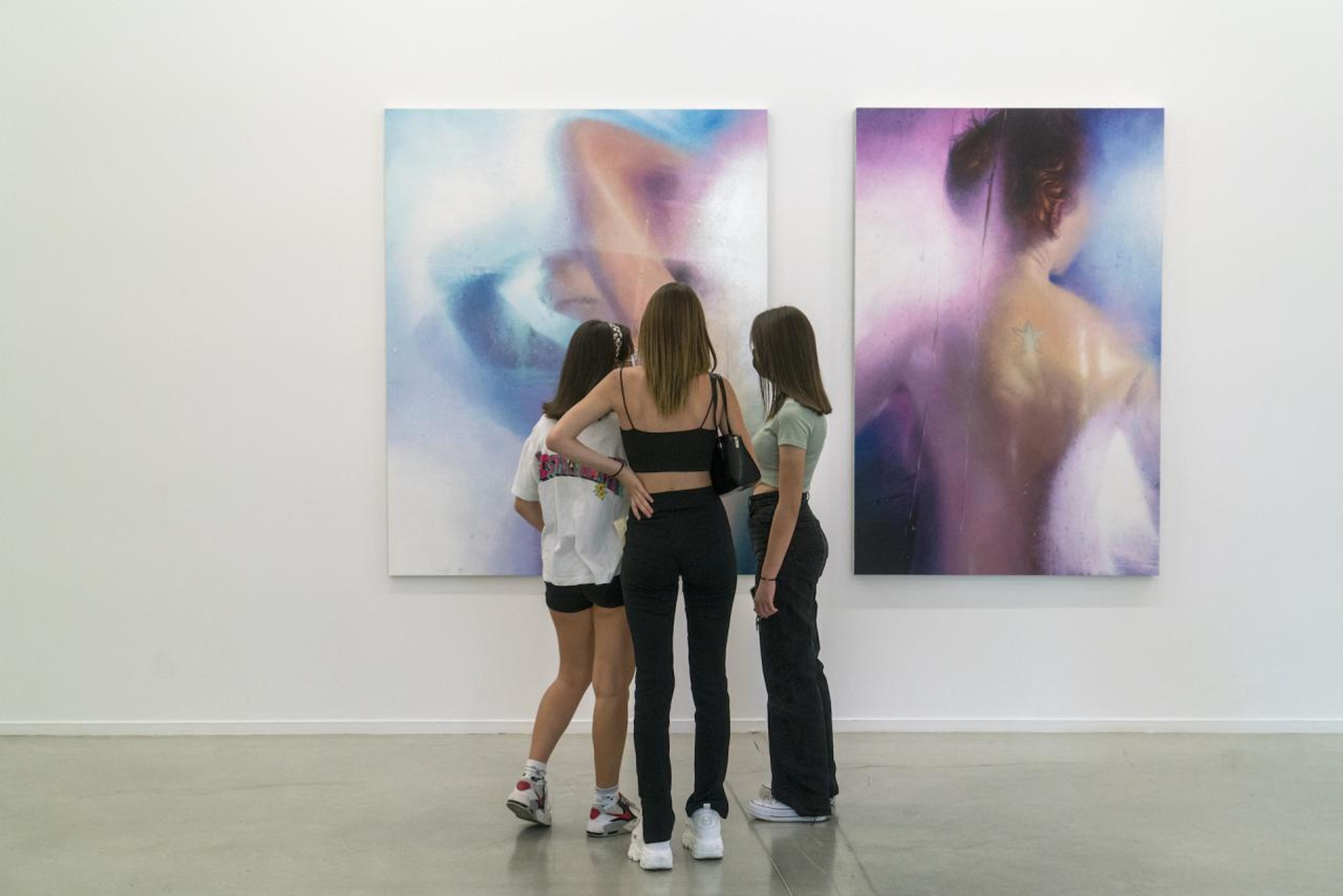“What’s the opposite of a feminist?” asks Marilyn Minter, with an amused weariness indicating the number of times the 1948-born American artist must have had to retell the joke as a shrewd elliptical answer to whether she herself is one. The punch-line is simple enough: “An asshole”. We are sitting in the garden of MO.CO. Panacée, preparing to enter a dual solo show: Minter and American painter Betty Tompkins’ (b. 1945), linked by a shared room as well as a sex-positive, pro-porn feminist sensibility. Assholes? Sure, there are some, scattered sparsely throughout Tompkins’ rooms, but the plat de résistance here is the pussy. That obscure object of desire, that blind spot of representation – even more so in an era when machine vision trained on an age-old fear of powerful women gradually supersedes the merely human gaze.
In Montpellier, the shows – respectively titled "All Wet" and "Raw Material" – are Minter and Tompkins’ first solo-shows in France. It is also the first time that they have ever exhibited together. Why? Again, the answer, in Minter’s words, is simple: “It would have been too much of a pussy-shock.” The two met in New York in 1976 through some ex-husbands, while knowing nothing of the other’s work and their closely interlinked positions. At the time, both of their practices, initiated at the end of the 1960s, had already become unwanted: not only because they were young (and young women to boot), but also because their work did not comply with the rejection of pornographic imagery that had begun to take hold in Lacanian-Marxist feminism and would remain influential through the 1980s and 1990s.
Marilyn Minter, Red Flare , 2018-2019, Lilith , 2018-2021, Nebulous , 2018. Courtesy of the artist, Salon 94, New York and Regen Projects, Los Angeles. © Marilyn Minter
In the exhibition spaces, curators Vincent Honoré, Anya Harrison, and Rahmouna Boutayeb have chosen to open both shows with a timeline running along the corridor joining the rooms. Delineating key moments of North American and European feminism through art, politics, pornography and censorship from 1969 to 2021, it comprises events such as journalist and activist Ellen Willis coining the term “pro-sex feminism” in 1981, Annie Sprinkle’s 1992 humorous video Sluts and Goddesses Video Workshop , curator Marcia Tucker’s 1994 controversial exhibition Bad Girls at the New Museum in New York, and scholar Linda Williams’ 2004 critical essay Porn Studies . One could also add to this list the French translation of artist and activist Valerie Solanas’ 1967 Scum Manifesto, finally published in February of this year.
The starting point of the poster hallway marks the year when Betty Tompkins moved to New York and started her iconic Fuck Paintings . Initially trained as a Post-Expressionist painter but soon stepping away from the dominant currents of Pop Art and Abstract Expressionism, she embarked on a series of grey-scale realistic paintings, subject matter sourced from her first husbands’ illegal collection of pornographic photographs imported from Canada. Cropped using tape, paper and a minimalist pencil grid, they show only penetration, erasing any marker of identity, face, ornaments or limbs. She then meticulously drew a grid over the motif in order to airbrush it onto canvas, enlarged to a monumental format of 2 by 1.5 meters.
They are dangerous and glamorous, tattooed and red-lipped, in full bloom and with a full bush.
In 1973, Tompkins shipped Fuck Painting #1 (1968) and Fuck Painting #5 (1975) to Paris, where she had been selected to participate in the show “A Flash of US Avant-Garde: Realism, New Realism” at the Espace Pierre Cardin. Their seizure at French customs marked the beginning of a year-long legal battle to retrieve them, as well as a brutal introduction to the history of censorship in art history – of which she knew little at the time, “except maybe Gustave Courbet”. Like all the best artists, Tompkins proceeded to turn critique into combustible material. The next year she embarked on her next series, which she kept working on until 2009 and picked up again in 2019 in a revised Instagram version. Censored Grids , first as drawings and then as paintings, stemmed from her decision to “do a better job” than her censors and thus regain legitimacy in the act. It also introduced language into her practice: first by repeating the word “censored” on the controversial parts of her subjects; later by reproducing chosen extracts from a submission of thousands of derogatory phrases to describe the feminine in Women Words (2002 – 2015).
Betty Tomkins, Fuck Painting #47 , 2012 and Fuck Painting #54 , 2016. Courtesy of the artist, P·P·O·W, New York and rodolphe janssen, Brussels. © Betty Tompkins
"Raw Material" gathers over fifty paintings from the last ten years: the most recent Fuck Paintings as well as the Censored Paintings , a grid of the quasi-abstract flesh landscapes of the Pussy Paintings, alongside the hitherto unseen preparatory collages and photo drawings. Despite having worked consistently since the 1960s, Tompkins’ public and critical reception was put on hold for three decades, the painting rolled and stored under the artist’s billiard table, until a 2002 show at Mitchell Algus Gallery.
Just like Tompkins, Marilyn Minter had been excluded from most shows dedicated to female artists in her time, subjected to the same moralist-patriarchal policing of the visible. A photographer, a painter and a videographer, Minter’s hyperrealist paintings from the 1980s-90s, Porn Grids , also proceed from erotic imagery. At MO.CO. Panacée, however, the centrepiece series, the Bathers , positions itself inside art history and the rich iconography of women at their toilettes. Historically in this tradition, taken up by male predecessors such as Rembrandt, Boucher, Ingres, Manet, Degas and Renoir, women have always remained a subject of the male gaze: fallaciously alone, often in a bucolic setting, while an off-frame predatory threat looms, as Linda Nochlin observed in Bathers Bodies Beauty . Undertaken in 2016, the artist’s own bathers are a contemporary version of women alone in the shower, seen through a steamy glass panel. Photographing models whose presence she likes, she assembles the elements from various shots in Photoshop to obtain a multilayered composition which serves as a base for the final painting, rendered in enamel on metal over a year-long process.
Minter’s women are flamboyant. Owning it. They are dangerous and glamorous, tattooed and red-lipped, in full bloom and with a full bush. In the final paintings, of which "All Wet" presents a selection of ten alongside the recent Bush Paintings, stemming from a rejected photoshoot for Playboy – too hairy to handle – and the video Green Pink Caviar (2009), the individual model similarly disappears through the blurry close-up. Minter pursues a strategy of indexical suggestion rather than full-frontal confrontation: she cosmetically idealizes her amazons of all ages, races, and body-types as an homage to women in general – and especially to those who, depending on perspective, will either be called difficult or free.
Marilyn Minter, Washout , 2019 and Star Tattoo , 2020-2021. Courtesy of the artist, Salon 94, New York and Regen Projects, Los Angeles. © Marilyn Minter Photos: Marc Domage.
La Panacée. MO.CO’s “pussy-shock” program is also the most un-Instagrammable of the season. In itself, this is a joyful feat: a slight hope that art institutions are still not entirely porous to corporate algorithmic control; that a “difficult” materiality will keep on resisting the macho-machinic gaze. On the other hand, as censorship increasingly focuses on identity over sexuality and more broadly on the political over the personal, the two women’s strategy might finally turn out be the timely one. Representation of marginalized bodies, even when carried out by marginalized subjects, will only ever feed back into moral-ideological instrumentalization while leaving aesthetics at the hands of the normative gaze.
Clearly, the free-floating organ-without-a-body – the degree zero of representation, as Baudrillard once named pornography – still holds a specific power. The autonomized pussy is its own master and subject and, like a purloined letter, it is hidden in plain sight: staring straight at you, it dares you to look back rather than hide behind an apparatus, be it technologically-mediated or socially constructed. It dares you to even try to capture it through your reifying camera lens, mocking your attempt to put its image into circulation.
“Marilyn Minter: All Wet” and “Betty Tompkins: Raw Material”
MO.CO. Panacée, Montpellier, France
26 June - 5 September, 2021
INGRID LUQUET-GAD is a contributing editor at Spike.





